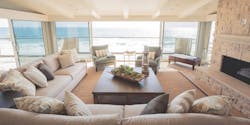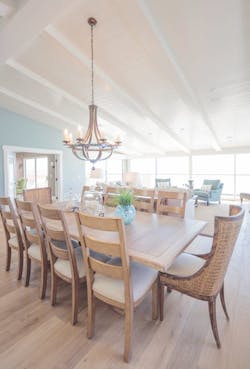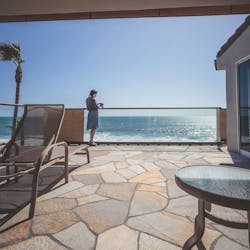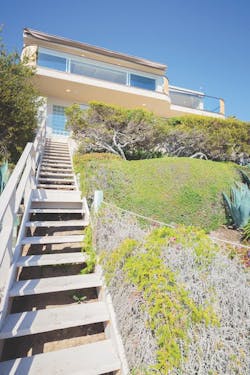When the owners of this home in Laguna Beach, Calif., remodeled it as a vacation property, they originally had limited plans for home automation. “Their intention was to have a few automated features to make management easier,” says Steve Stary, executive vice president of sales for Brilliant AV in Costa Mesa, Calif., a provider of audio, video, lighting, security, and Control4 automation. “But once they learned that the smart home is capable of more, they gave us the okay to ‘go for it.’”
Brilliant AV made the entire home smart, with automated lighting, shades, alarms, HVAC control, outdoor audio, and scenes that interoperate each component, all powered by Control4. They coordinated their efforts with the remodeler, Ground to Gable Construction of Laguna Hills, Calif., who performed an extensive interior renovation.
Stary is a CEDIA Certified Professional Designer (CCPD) and a licensed electrical contractor in California. He filled in Design Innovation on the details of the design and installation of the home-automation system. Also joining the conversation: Brad Hintze, senior director of product marketing at Control4, and Ken Bailey of Ground to Gable Construction.
DI: How old was the existing house, and what were the clients’ goals for the remodel?
STEVE STARY: The home was built in the 1980s, and is perched on the edge of the Pacific Ocean. No one lives in it full time; instead, it’s a vacation home for the clients and their friends and family.
Ground to Gable Construction demolished the interior of the existing home down to the studs. While automation was always part of the clients’ plans, it was pretty bare bones at the beginning. We were just going to add some music and put a TV here or there.
Originally there were 6-inch can lights with small spotlights on the main floor, so when you flipped the switch, there were pools of light all over the place. Except for a few electrical outlets, we completely rewired the house because all the dimmers were moved and the fixtures replaced.
DI: So your company played a big role in the project?
STARY: Quite a large role, yes. Our initial discussions were about TVs and speakers, but when we brought up the concept of lighting control and dimmers, the client got very interested because aesthetics were super important to him. He didn’t like the existing light fixtures and all the banks of switches on the walls, so he warmed to the prospect of cleaning them up with a simple keypad.
Ultimately we helped redesign the lighting layout for the entire house and ended up doing the electrical work as well, which we don’t often do. But sometimes you get clients that are willing to pay for white-glove service.
DI: What did the installation of the home-automation system entail?
STARY: The technologies we used are almost exclusively wireless. We didn’t need to run wire to make the home-automation system function, although we did have to have wire for certain things such as the speakers, because they involve power. But communication wise, everything in the house uses a pretty robust sort of wireless protocol.
DI: Ken, was it relatively easy to coordinate your crew and schedule with Brilliant AV?
KEN BAILEY: Yes! The best part was that Brilliant AV also acted as our line-voltage electrician, allowing for a more seamless integration of all the parts. When [a home-automation installer doesn't] do line voltage, it's very difficult to coordinate all the moving parts.
DI: Brad, can you give me a rundown of the smart features?
BRAD HINTZE: It was designed to be easy for the clients to manage from any location, and easy and intuitive enough for their guests to enjoy without complicated explanations. It's a whole-home automation system that controls everything including the thermostat, TVs, audio system, lighting, door locks, shades, and alarms.
The clients can prepare the house for a last-minute arrival by lowering the temperature of the air-conditioning system, turning on exterior lights, and opening the shades to reveal gorgeous views of the beach. Guests can pair their music to the system if they so desire. Numerous “scenes” can be set with the touch of a button. The “goodnight” scene, for example, lowers shades, sets a lighting path, locks the doors, and sets the thermostat to night mode. The Control4 Door Station, which includes a doorbell and intercom, is connected to the outdoor rock speakers so when the clients are at the beach they can hear when a visitor is at the door and let them in remotely via smartphone.
When the house is empty, it lowers the shades and adjusts the interior temperature and lighting to limit sun exposure, conserve energy, and make it appear occupied.
DI: How does the system work? Is there a central command center?
HINTZE: The system is configured using an EA series controller and the Control4 OS. The system is programmed in Composer Pro and managed by clients and guests via numerous interfaces including the Control4 app, remote-control touchscreens, and keypads that create a singular user interface and a seamless user experience.
DI: What else is noteworthy about the technology?
STARY: The main floor has smart LED lighting, so there are no dimmers on that floor. The fixtures are wired like electrical outlets where they all loop together. The smart-home system "talks" to the individual can lights, and we programmed it all from there. That’s a Lutron technology.
DI: Is the Control 4system compatible with other devices?
HINTZE: There are more than 10,000 interoperable devices that connect on the Control4 platform including light switches, keypads, door locks, thermostats, alarms, garage-door openers, shades, and entertainment equipment. This gives homeowners a lot of flexibility in choosing new products and integrating them into the system.
DI: Can homeowners install a basic system and easily add features later on?
HINTZE: Control4 systems are designed and installed by professionals to provide homeowners with a level of control and personalization that complements the home. They can start with a single EA controller and handheld remote to manage their family-room AV system, and easily add lighting and a thermostat. They can have their installer add on other items over time, such as automated shades or multi-room audio.
DI: What are some common misconceptions about home automation? Is it perceived as too expensive?
HINTZE: Home automation isn’t cheap, but it’s not out of reach either. Home automation is proving to be worthwhile whether it’s for managing energy consumption or keeping tabs on who is coming to and going from your home. But the true value of a smart home isn’t in cost savings or delivery alerts; it’s in enhancing your lifestyle. It gives you more time for other pursuits and creates a perfect environment of comfort and beauty throughout your property. Whole-home automation systems, when compared to singular do-it-yourself solutions, cost more but do more as well.
Another misconception is that it’s too hard. Home automation might seem overwhelming for a person who struggles to find the right buttons on the TV remote, but Control4 is designed to streamline technology. Instead of juggling different remotes, apps, and devices in every room, homeowners and guests have one simple user interface that looks the same on every device whether it’s a mobile phone, a tablet, a remote, or an in-wall or portable touchscreen. With one app, and now voice control, it’s easy for the homeowners, kids, babysitters, and even grandparents to control the house.
DI: Can you provide ballpark figures for the cost of a Control4 system?
HINTZE: A Control4 entry-level controller bundled with a handheld remote starts at $600, plus installation. In an internal customer survey, Control4 customers described their homes as upper-middle-class to upper-class, and had an average of 40 devices connected to their system.
DI: What are the most cutting-edge features of home automation today? For example, what are you seeing in high-end luxury and custom homes?
HINTZE: Voice control is one of the fastest-growing home technologies. According to Business Insider, the most attractive feature of voice control is that it’s hands-free. When your hands are full, when you’re cooking, or when you’re across the room, you can give your house a shout instead of reaching for a light switch or smartphone.
Amazon Echo, for example, has been quick to accelerate voice control in the smart home. With Control4, homeowners can do even more than tell Alexa to turn on individual lights or adjust the temperature. With smart-home scenes, a single command to “turn on kitchen” sets appliances to the perfect temperature, controls lighting, and even starts up a favorite playlist.
But voice control is the not the answer for everything. Trying to get Alexa to hear you say “pause” when you’re outside in the yard or watching an explosive movie scene has challenges. That’s why all systems should have multiple interfaces for quick access and control.
In the luxury-home market, we see homeowners pushing the boundaries of the traditional smart home, adding control of less common devices such as gas fireplaces, in-pool speakers, icemakers, motorized wine racks, dog doors, or even hidden TVs.
DI: When they’re planning to build a new home, how soon should clients start talking to their architects and builders about home automation?
STARY: It’s never too early to have that conversation. If home automation involves TVs and speakers, wiring will have to be done in the pre-drywall phase. But ideally it should be planned in the design stage when the clients are considering their HVAC system and whether or not to install in-floor heating, for example. It’s best to discuss at that point, when there’s more money in the budget.



